Updated: 13 May 2025 09:30 CEST
On 10 May 2025, an uncontrolled reentry took place of the Cosmos-482 descent craft, a Venera landing capsule that launched 53 years earlier. It was meant to land on Venus, but its launcher never escaped Earth’s gravity.
The Soviet-era object was last spotted over Germany at 08:04 CEST on 10 May by our colleagues at Fraunhofer FHR as it passed through the sky over their antenna. Because the descent craft was not spotted one orbit later, at the expected 09:32 CEST pass, the reentry can be assumed to have occurred between these two times.
A precise time and location of its reentry have so far not been identified. We have not received any reports on direct visual observations of the final reentry or of any impacts on ground.
This GIF combines images of Cosmos-482 tumbling through space on Thursday 8 May, about 2 days before reentry. The overlay image in the GIF helps to identify the orientation and what is reflected in the radar image.
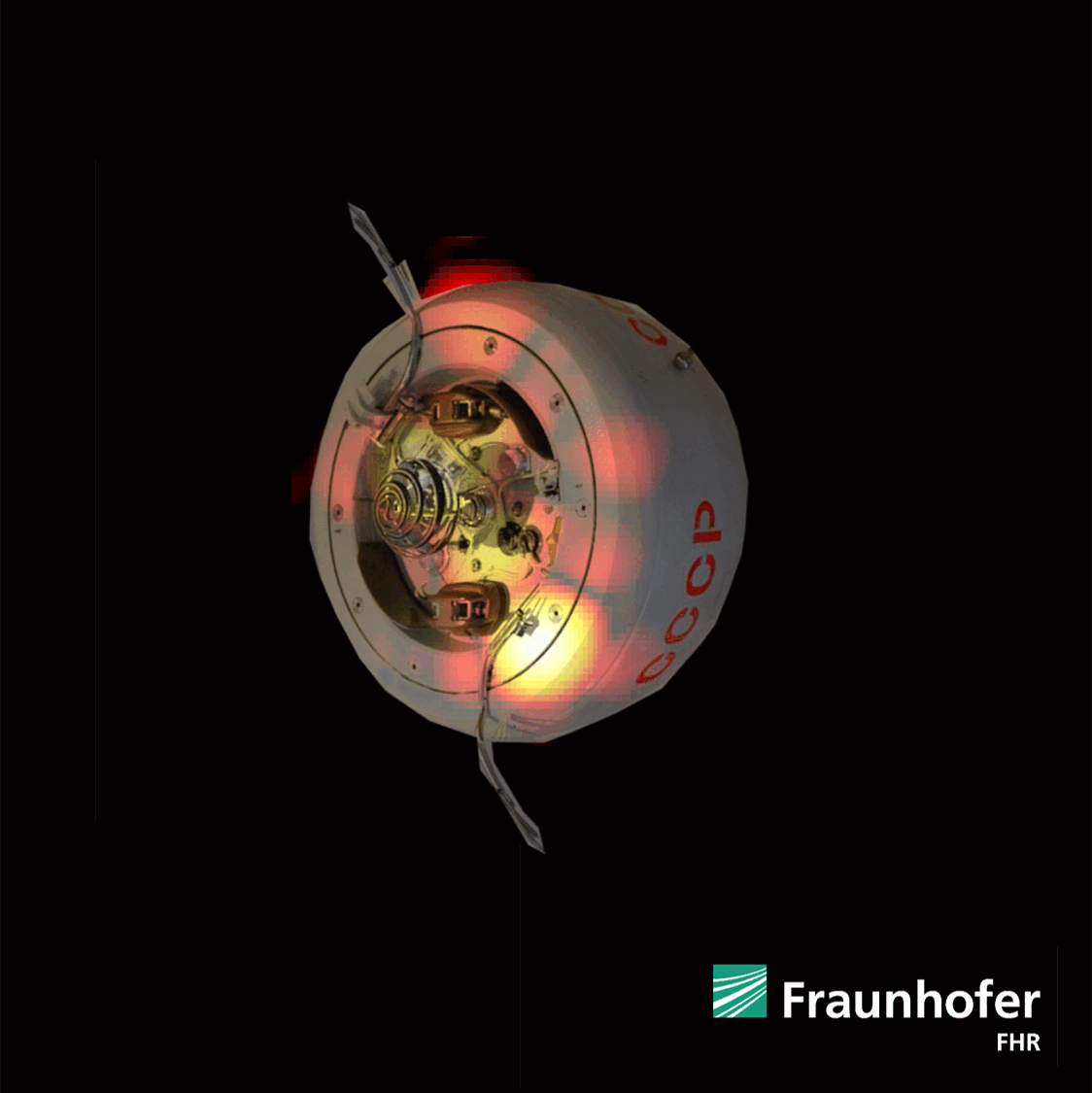
The images were captured by the Tracking and Imaging Radar (TIRA) at the Fraunhofer Institute for High Frequency Physics and Radar Techniques FHR in Germany. The TIRA-acquired radar tracks helped to improve the knowledge of its orbit and finetune our reentry predictions.
ESA thanks Fraunhofer Institute for High Frequency Physics and Radar Techniques FHR for their support in providing measurements of their space observation radar TIRA.
Previous entries
On 10 May, an uncontrolled reentry will take place of the Cosmos-482 descent craft, a Venera landing capsule that launched 53 years ago. It was meant to land on Venus, but its launcher never escaped Earth’s gravity. Now, the descent craft will come down at a point between 52° North and 52° South of the equator. As the reentry comes closer, the predictions will become more precise in the updates below.
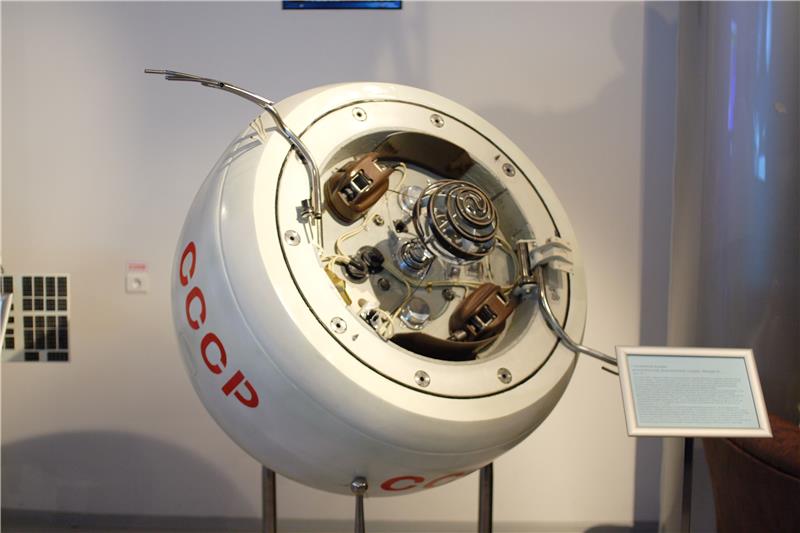
Status 10 May 14:21 CEST
As the descent craft was not spotted over Germany at the expected 07:32 UTC / 09:32 CEST pass by our colleagues at Fraunhofer FHR , it is most likely that the reentry occurred on the track between 06:04 UTC and 07:32 UTC. The latest prediction diagrams have been updated accordingly but reflect the commonly used full prediction uncertainties where ESA’s Space Debris Office predicted that the reentry of the descent craft will have taken place at:
06:16 UTC (08:16 CEST) on 10 May 2025
The uncertainty in this prediction was +/- 0.36 hours. See further down for the latest prediction graphs.
We have not received so far any reports on visual direct observations of the final re-entry, or on any impacts on ground.
Status 10 May 09:56 CEST
As the descent craft was not spotted by radar over Germany at the expected 07:32 UTC / 09:32 CEST pass, it is most likely that the reentry has already occurred.
Status 10 May 08:35 CEST
The descent craft was seen by radar systems over Germany at approximately 04:30 UTC and 06:04 UTC, corresponding to 06:30 CEST and 08:04 CEST, respectively. There is no further update on the estimated reentry window as we are now roughly in the centre, corresponding to the red dot labeled COIW (centre of impact window) in the ground track chart below.
Status 09 May 19:15 CEST
ESA’s Space Debris Office currently predicts that the reentry of the descent craft will take place at:
06:37 UTC (08:37 CEST) on 10 May 2025
The uncertainty in this prediction is now +/- 3.28 hours.
See further down for the latest prediction graphs.
Status 09 May 12:12 CEST
ESA’s Space Debris Office currently predicts that the reentry of the descent craft will take place at:
06:26 UTC (08:26 CEST) on 10 May 2025
The uncertainty in this prediction is now +/- 4.35 hours.
See further down for the latest prediction graphs.
Status 08 May 18:30 CEST
ESA’s Space Debris Office currently predicts that the reentry of the descent craft will take place at:
08:16 UTC (10:12 CEST) on 10 May 2025
The uncertainty in this prediction is now +/- 8.61 hours.
See further down for the latest prediction graphs.
Status 08 May 09:00 CEST
ESA’s Space Debris Office currently predicts that the reentry of the descent craft will take place at:
07:12 UTC (09:12 CEST) on 10 May 2025
The uncertainty in this prediction is now +/- 13.67 hours.
See further down for the latest prediction graphs.
Status 07 May 14:00 CEST
ESA’s Space Debris Office currently predicts that the reentry of the descent craft will take place at:
06:18 UTC (08:18 CEST) on 10 May 2025
The uncertainty in this prediction is now +/- 18.07 hours.
Latest prediction diagrams
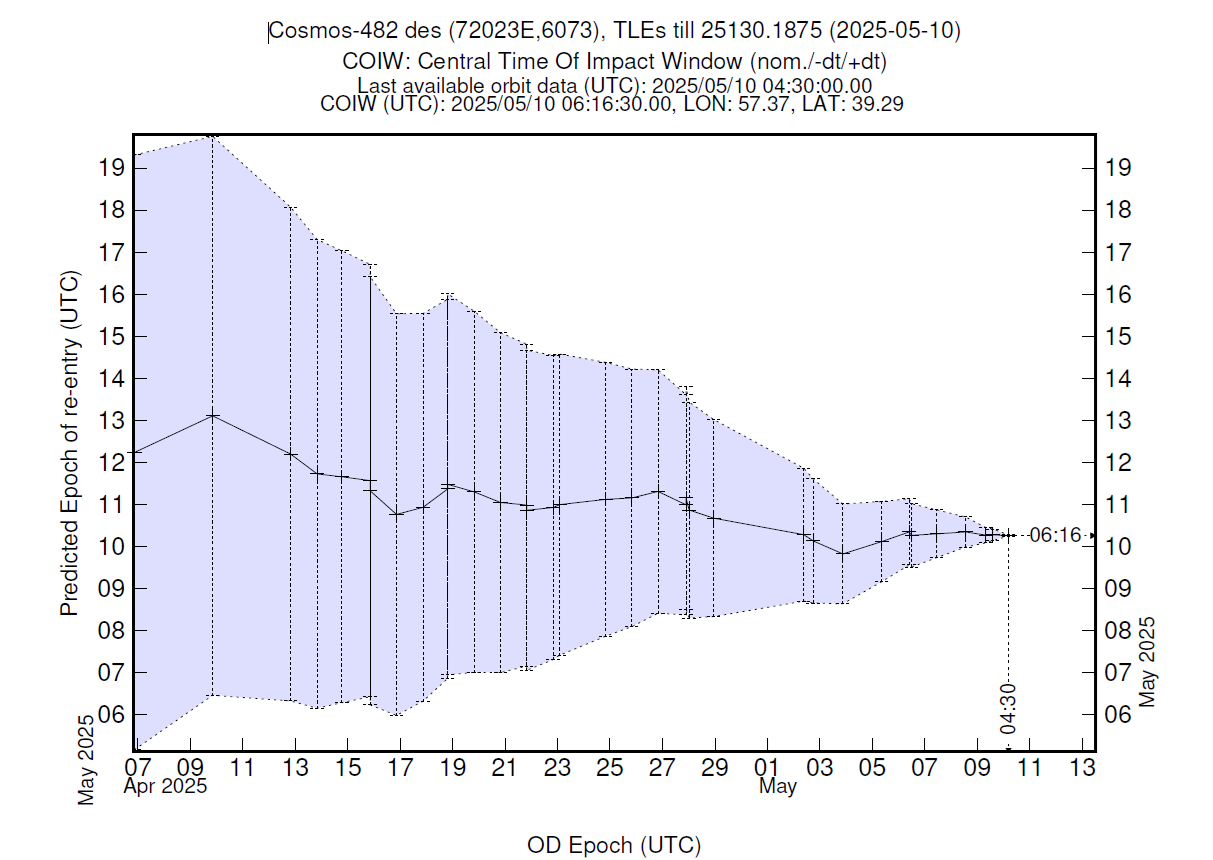
This is the latest graph showing how the predicted time of reentry has changed over the last month. As we approach the reentry, the uncertainty in the prediction decreases. The remaining uncertainty is cause by the difficulty of modelling the atmosphere, the influence of space weather and the unknowns about the object itself, such as which way it is facing.
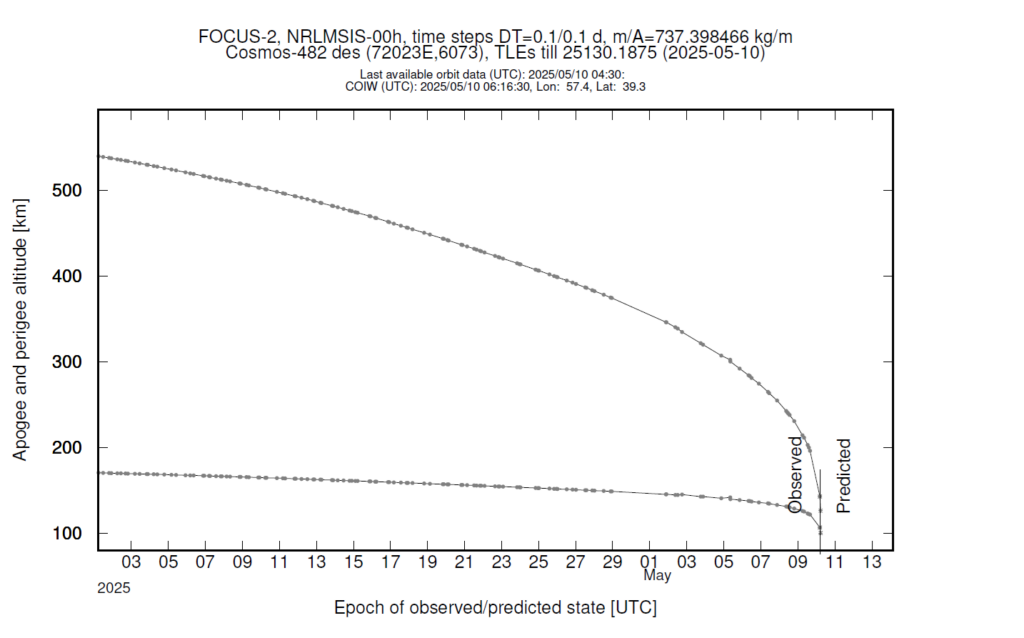
This is the latest graph showing how the altitude of the Venera capsule has changed over the last month, and how it is expected to change in the future.
As its orbit is not a perfect circle, two lines are shown:
- The upper line shows the descent craft’s ‘apogee’ – the point in its orbit at which it is further from Earth.
- The lower line shows the descent craft’s ‘perigee’ – the point in its orbit at which it is closest to Earth.
At any particular moment, the Venera capsule at an altitude somewhere between these two lines.
Values before the vertical line show real data obtained via observations of the capsule made using sensors on the ground. Values after the vertical line show how the capsule’s altitude is expected to evolve in the future, until it fragments into pieces at an altitude of roughly 80 km.
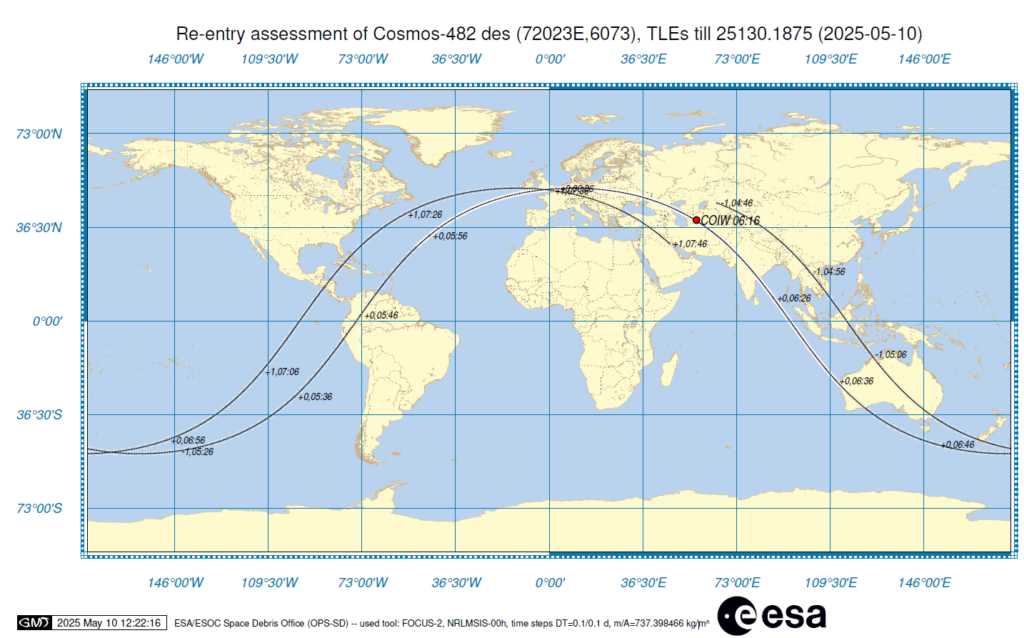
This is the latest available ‘ground track’. At the current predicted time of reentry, the capsule would be located approximately 10 km over the red marker, labelled COIW (centre of impact window). It is here that we currently expect the satellite to break up, but there is still a high uncertainty in the precise location where it will fall.
This is because the object might reenter at any time within the current uncertainty window, a different reentry time means it would be at a different location along the ground track. The lines of the ground track show where the satellite will be during the entire reentry time window, which at this point still includes multiple orbits around Earth.
Frequently asked questions
What is special about this reentry?
The landing module could reach the surface of Earth in one piece instead of breaking and burning up. The Venera landing capsule, launched in 1972 by the Soviet Union, was part of an attempted Venus probe which failed to escape low Earth orbit. The 495 kg lander was made to withstand the extremely harsh conditions of Venus’ hostile atmosphere and designed to 300 G’s of acceleration and 100 atmospheres of pressure. As a result, it might survive its reentry into the atmosphere.
In addition, the special, smooth aerodynamical shape of the spacecraft allows it to function as a measure of the density in very low Earth orbit. Every time the elliptical orbit passes through the perigee, it loses apogee height. The atmospheric drag on the object can be inferred from the altitude difference right until reentry. The design of most spacecraft is too complicated to make accurate measurements, but the Venera descent craft’s nearly spherical shape does allow it. This turns its reentry into an ‘accidental’ reentry science experiment.
How often do such reentries happen?
Satellites and rocket parts of moderate size reenter almost daily, while small-size tracked space debris objects reenter even more frequently. Pieces that survive have only very rarely caused any damage on the ground. With the increasing space traffic, we expect that reentry frequencies increase further in the future.
Can reentries cause injury?
The risk of any satellite reentry causing injury is extremely remote. The annual risk of an individual human being injured by space debris is under 1 in 100 billion. In comparison, a person is about 65 000 times more likely to be struck by lightning.
More information
- Space Debris at ESA
- Reentry predictions maintained by the ESA Space Debris Office
- ESA Space Safety Programme

Discussion: 58 comments
One of those tracks lines up with where I live! I hope I get to see it!
Will you see it through the smoke ?
Probably if an infrared camera is used.
oh no you don’t….
Mine too. Thank you. for the. Understandable info you have given. I live in Victoria Australia and this “little old lady” is very interested. Thank you once again.
Whilst keeping in mind that the number of variables which need to be factored into the equation to make most (if not all) predictions made anywhere by anyone about the when’s and where’s this vintage lump of probe will re-enter, I’d like to say that this webpage is the most complete and well explained I’ve seen about the upcoming COSMOS 482 re-entry I’ve seen. I am far from being an expert on such things but have some prior experience and alot of interest in watching the skies. I realise that you wonderful people are the ESA (a credible and reliable source of science information), and not a tabloid newspaper but I still just wanted to commend you for the information and the way it is presented here. Good work and thank-you! 🙂
As Cheech has commented (his name is RAALPH man! :D), I too hope to capture a glimpse (or even better, a sequence of long exposure images of this event occurring over Australia after sunset lol, not sure of the odds of that occurring). Anyway, thanks again for the concise explanation and presentation of the data available.
Thank you so much for the lovely compliment. And we’re with you, watching the skies for that streak on the other side of the globe from you, as long as it comes down safely!
Is there a much higher resolution map available for the European region? I’d really really like to see what exactly the paths are across European countries! (Which towns it may fly over)
You can just zoom in in a browser, it’s hires file.
right click image to open in a new browser tab.
On estimating re-entry location: don’t we know that the re-entry will occur near a perigee position? Could you mark those on the orbits. Maybe even estimate where it would be compared to the perigee? It seems like it should be possible to narrow it down to just a few possible locations.
It will be decelerating through all of its orbit due to friction with the atmosphere, with the highest deceralation occuring at perigee where the atmoshpheric density will be higher. But it could make it through a perigee with just enough velocity remaining to make some fraction of the next orbit, and actually “take the plunge” anywhere along that orbit.
Is there a posibility to be destroyed by a missile???
It (the satellite) and all that debris would be much harder to detect, and where it would fall..
But easier to be destroyed by atmospheric friction. Specially, since the debris will not be protected by te external shield designed for Venus.
But nobody wants to recognize its ability to destroy space elements …. plus who wants to create a diplomatic conflict with Russia nowadays?
Since the likelihood it falls in an inhabitated place is remote, and even more remote in an advanced country city, who cares?
So now that a tighter reentry window exists where can I see the orbital track for 5-10-2025 at 0600UTC +- 5 hours. Large portions of earth won’t get a fly over during the window.
The orbital track at around 0600UTC is the one shown in the map running through the red dot annotated ‘COIW’.
will it be visible over europe becouse i want to see it but i dont know if i will be able to (i live in poland bdw)
I hope I’m not in line when times come 😀
Here’s what I’m using to track it: https://www.n2yo.com/?s=6073
Can you put anticipated re-entry time in GMT?
For most purposes related to spaceflight, UTC = GMT.
Some imagery of Cosmos-482 over 13 years time, compared another – even older – small object, a Vostok upper stage https://spaceweathergallery2.com/submissions/pics/r/Ralf-Vandebergh-Cosmos482_2011_2014_2024_fullres_1746662604.png
Some images showing the actual round shape of the small capsule, compared to the bus of a first generation (V1.5) Starlink satellite in operational orbit, but 130 km further away. It is easy to correct for the distance and estimate the size of the bus which corresponds very well with the width of the Starlink bus (1.3 – 1.4 meters according to SpaceX).
https://i.postimg.cc/RFnjRrCt/Cosmos482-20240707-comparison.png
Great information and updates, thank you!
Is it likely to leave a trail visible to the human eye such as you would expect from a falling meteor?
Generally speaking, space debris reentries can be seen with the naked eye (an example: https://www.esa.int/ESA_Multimedia/Videos/2015/02/ATV-1_reentry), they move slower than meteors but still very fast, but it depends on weather and visibility conditions, and, of course the location.
While it will most likely fall into the ocean, I kind of hope it lands safely in a field or a desert, so it can be recovered and studied. It would be fascinating to see the effects on a satellite that spent over 50 years in space.
Interesting question. If it falls into, let’ s say , Australia or its territorial waters, Does Australia have the right to investigate it , or only Russia can do it? If Russia, why Russia and not Latvia or Uzbekistan since they were part of the Soviet Union when it was launched.
I think this can cause a diplomatic conflict nowadays, so I believe nobody show interest doing such research (unless it falls into Russia or one of its puppet nations)
Great work. Very interesting indeed! Thanks for sharing and updating!
What means for instance +1,08:47 and why next is +2,08:57 in the orbits map? What means the first number?
The first number means the orbit number in respect to the orbit of COIW, so 0 ist the orbit of the COIW, +1 the following etc. (COIW: center of impact window)
I wonder why it was not hit by a missile because it is known that it will survive the reentry: if the risk of hitting a person or building is 1/100.000 it would be worth it.
Because the likelihood is quite smaller than 1/100000 and the likelihood that it is in a wealthy country is
I had the same idea as Venusian. Let’s say it that way, ‘Who would pay for that?’ or much darker, ‘Who has a missile left, to hit an former soviet objekt?’ Russia? Trump or even his former buddy Elon? 🙂
I’m still baffled that in 2025 we still have no ai that can accurately tell where it’s going to fall .
This is just mathematics and using all the variables that affect re-entry. This is something that an ai Can be trained on .
Many variables are too unknown and of significant influence here, such as local atmospheric conditions, which way the object is facing on descent, how it fragments etc. You can’t model reality. Well, you can try to model it, but do not expect it to be the same as reality.
No, it’s not, it’s physics. As far as you don’t know all the variables, you’ll get some uncertainty. You can train the AI if there are thousands of cosmos 482 coming down, yes, but we have (fortunately) only one 🙂
ESA have experts, so if they tell you it’s not predictable precisely, why not simply believe them?
Tell me you don’t know what AI is without telling me what AI is:
AI is “just mathematics” which is then trained on data already produced by people, to yield (in the case of ‘black box’ algorithms) unreliable outputs that will just have to be checked for errors by experts anyway.
Just wondering if it is at all possible that I saw something related to this last night (10 May approximately 01.00 CEST)?
It can’t have been Cosmos-482, as at that time, the object was not visible to the naked eye.
Appreciate this article, nicely explained. No way for Russians to try and deflect it I suppose? Let’s hope it doesn’t hit anything vital.
I really wish you would provide information about expected radar spottings before they actually happen, rather than only afterwards. I personally would have liked to know as German citizien that it was expected above us at the times you mentioned. So whereever it came down now I just hope it didn’t hit anyone.
If you scroll to the image with the ground track on this page: that indicated beforehand the path that Cosmos-482 would travel along. You can check out such ground track diagrams beforehand to see if it passes by anywhere near you.
Hi, thank you so much for your updates. On this online tracking page i can still see it (on an altitude of 136km). Is this another object ? I’m confused. Thanks for your help! https://www.satflare.com/track.asp?q=6073#TOP
I can’t replicate what you saw, but it was not at that altitude anymore at that time. Such page does a simple propagation (forward projection) of the latest available orbital state of the object which may not properly account for drag effects, therefore not losing the altitude as it should.
I believe I can see it. I live in Cross Junction, VA.
There was a bright star looking thing in the sky to the east of me. It was moving very slowly. It now looks less bright but the sun is rising.
It’s still visible to me but it’s moving west. I’ve been watching for 30 minutes.
The object you saw seems to have been moving too slow for it to have been the Cosmos-482 descend craft. The Cosmos-482 object completed one orbit around Earth in about 90 minutes and would have moved much faster. Also, the object would be moving from West to East.
Descent craft was NOT spotted by radar over Germany.
Descent craft WAS spotted by radar over Germany.
Which is it???
Both
It was spotted over Germany at 8:04 CEST but not at 9:32 CEST, this means it has likely reentered in between these times.
Has there been any confirmation that it’s down yet?
Latest news is that it has crashed in the Indian Ocean near Java (Indonesia)
According to the New York Times, Roscosmos has said that It splashed down in the Indian Ocean west of Jakarta, Indonesia (https://www.nytimes.com/2025/05/10/science/kosmos-482-crash-soviet-spacecraft.html).
We saw the a bright glowing little light at exactly 09:37 CEST in Berlin. Not quiet over the head, but almost. Comming wrong West direction going south east.
Well also have a Photo, we can share it with you Guys.
https://imgur.com/a/fvY8roz
The little bright dot in the left Side.
09:37 CEST. Berlin
Spotted a flare in the sky at around 6:10am AWST on 11/05/2025, from location 401230E, 6806953N Zone 51 J UTM
Object low in sky not far above horizon, Bright yellow to orange was in view for about 4 seconds between headings of 192 and 185.
06:10am AWST does not correspond to a time the Cosmos-482 reentry might have happened. At that time the object had already decayed.
It is incredibly hard for me to believe that only Germany was tracking and the window is ~1.5 hours. Especially once it was closing in on ~80km altitude. It got low for a bit over China but didn’t fall in.
At 4.85Mi/s it didn’t slow enough to fall in.
SO.. any new reports from NORAD, etc?
Because I’m not believing no one knows.